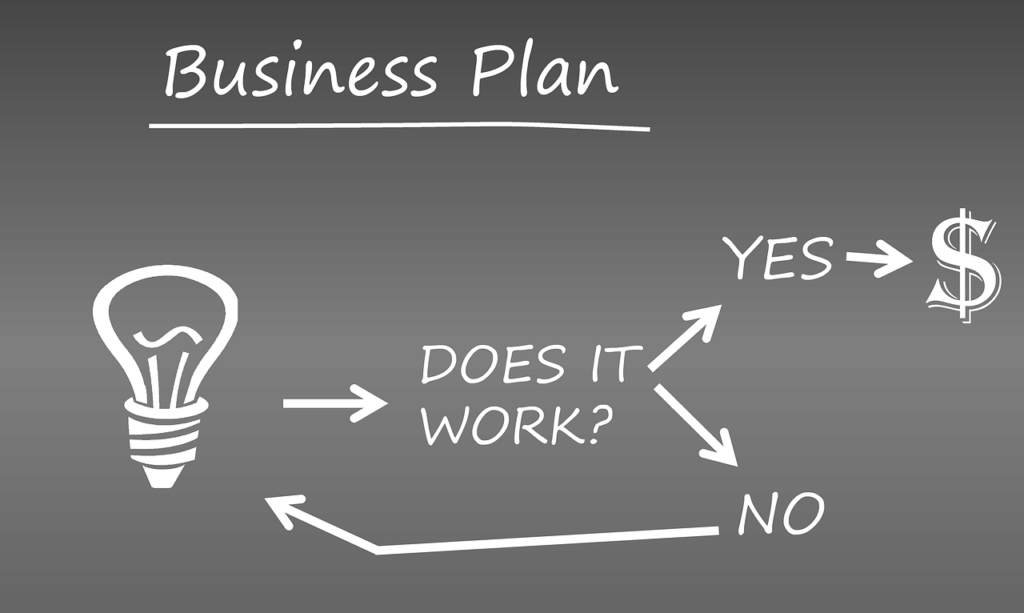This is going to be FUN! (I promise.)
If you are a solopreneur like me then YOU are your business.
So let me ask you, “What’s YOUR plan?”
And by that, I mean, “What’s your BUSINESS PLAN?”
Because even if you are a one woman (or man) show – maybe especially if you are a one woman (or man) show – you need to define:
- What you plan to do
- How often and how much of it you plan to do, and
- What you hope to see as a result
(Write that down.)
You should draft your solopreneur business plan at or near the beginning of your solopreneur venture … maybe even before you do, in fact, venture. And you should make your plan specific, measurable, and most of all achievable.
Business Plan? … “YUCK!!”
“Yuck!” you say. Unless you are the stereotypical “left-brained” thinker. (Even I say “Yuck!” … and I definitely lean analytical.)
I think the “yuck” factor for many of us is that business plans typically encompass things like “market analyses” and “financial projections” – things that seemingly require a high-level of professional expertise to create and understand.

And haven’t we just said we are solopreneurs? And most likely also not CPAs or marketing professionals?
Recognizing this (or because they themselves don’t understand it), many online articles that aim to explain writing a business plan to the masses state that your business plan MUST include “market analyses” and “financial projections” and the like, but provide no detail as to how you, an average person, might go about creating these “vital” documents.
So now – because you have taken the idea of creating a business plan seriously enough to have read a few online articles on how to do so and still have no clearer idea of how to execute your plan than before you read those articles (you only know that it is critical to your success that you do so) – you are feeling overwhelmed and anxious and stuck.
So you chuck the planning and launch yourself “pantser” style toward the promised land of earning a “full-time income” as “your own boss” while “working from anywhere,” income that ultimately becomes “passive” so that you “don’t have to work another day in your life” and can devote yourself entirely to “following your bliss” and “living your best life ever.”
Sound familiar?
Have I got that about right?
Creating a Manageable (FUN!) Solopreneur Business Plan
To be fair, a proper tutorial in writing a professional business plan requires more than an article – a book, at least, if not a course.
And you could easily spend several of the first months of your “solopreneurship” simply being a business plan writer – and that’s probably NOT your plan. Right?
Still you need to have some idea of where you are going and how you plan to get there.
And if thinking through that in the context of the business you intend to create – YOUR business – doesn’t seem at least a little fun, then you definitely need to ask yourself, “Are you sure you want to pursue this venture in the first place?”
The good news is that while your solopreneur business plan should outline where you are going and how you plan to get there. Or, as I said in the beginning:
- What you plan to do
- How often and how much of it you plan to do, and
- What you hope to see as a result
It only needs to meet YOUR NEEDS … and no one else’s.
Your Solopreneur Business Plan Only Needs to Meet YOUR NEEDS
“There’s no right or wrong way to write a business plan. What’s important is that your plan meets your needs.” SBA
God bless the US Small Business Administration (SBA) for this gem from their article, “Write your business plan.” A very useful article in general, the SBA’s article begins by doing the most useful thing of all – it distinguishes between a traditional business plan and a simpler version that provides a high-level summary of the key/most important elements of your plan, what the SBA calls a “lean startup” plan.
The traditional business plan format, the SBA explains, is a detailed, comprehensive plan often “dozens of pages long” and designed to meet the requirements or prospective lenders and investors. (Probably what most of us are thinking of when we hear the words “business plan.”)
A “lean startup” plan, on the other hand, focuses only on the most important elements of your plan, often at a high level, and can be as brief as one page – backed up by relevant charts, of course – and can take as little as one hour to write.
Now you may need a bit more than one page and one hour, but as you probably are not going after funding at this point you don’t have to create a ponderous document for an audience of investors. And you also don’t need any charts.

Your audience is YOU and as the SBA says, “What’s important is that your plan meets your needs.” You don’t have to follow an “exact business plan outline” and you can use only “the sections that make the most sense for your business.”
And since its just for you, your business plan can be in whatever format you find most effective. You like spreadsheets? Record your plan in a Microsoft Excel or Google Sheets workbook. Do you journal? Write it out and keep it in a ring binder (old school!). More of a visual person? Think of your business plan as a vision board. In fact, make it a vision board and hang it on your home-office wall.
(If you’d like to read the full SBA article for yourself, you can link to it from here!)
BUT Do Try to Cover These Important Elements (at least)
In the next article, I will go into each of these elements in more detail. AND I will use my own business plan as a real-world illustration, explaining step-by-step how I created each element and showing you what each element of your solopreneur business plan might look like.
But first I want to wrap this article up by identifying the elements that I think are important to address in your business plan.
Borrowing again from the SBA, traditional business plans typically include the following sections:
- Executive summary
- Company description
- Market analysis
- Organization and management
- Service or product line
- Marketing and sales
- Funding request
- Financial projections
- Appendix
Ours is going to include these elements:
Executive summary. You will summarize what your company is.
Company description. To the best of your ability, you will answer the following: Who is your target customer (or audience)? What product or service do you plan to offer them (or, to put it differently, how do you plan to make money)? What makes you different from your competition?
Market analysis. I feel like I implicitly promised you no market analysis and, in a sense, I plan to stick to that promise. That said, one of the first things you will be advised to do in launching your MMO (“make money online”) business is to “choose a niche.” There’s tons to be said about choosing a niche, so more about this later. But for the moment just remember that your chosen niche will not exist in a vacuum – it will exist in a market.
Organization and management. This won’t be part of our plan. Its just you so no need for an organizational chart.
When it comes to "organization," at some point you should consider the tax and liability implications of your business structure. As an example, if you are in the US this might involve choosing between being self-employed and incorporating. Such considerations are outside the scope of this article, but if you'd find it helpful, I can give you the broad strokes and a list of resources in a separate post. This is not my expertise, but I have been through this process myself and am happy to share what I learned.
Let me know if you are interested in the COMMENTS below.
Service or product line. We have already addressed this in the company description – What product or service do you plan to offer your customer/audience? If you’d like to add more detail, keep this section and do so. Otherwise you can skip it.
Marketing and sales. If you are just now learning MMO – whether through a course or via your own, self-directed YouTube video education – a good bit of your early instruction will address figuring out how you will attract and retain an audience/customers and how a “sale” will happen.
The above link is my Wealthy Affiliate affiliate link, by the way. I am a member of Wealthy Affiliate, which is where I learned the basics of affiliate marketing. If you follow the link and decide to join yourself I may earn a commission. There is no extra cost to you. Plus you'll get an affiliate link of your very own! But honestly, that's not really the point here. Here I just wanted to give you an example of what an affiliate marketing course and community might look like.
Funding request. NOPE.
Financial projections. Don’t worry, there will be no need for balance sheets or cash flow statements here. However, I assume you have some monthly bills to pay (as a person, not a business … though possibly that too) and you need to have income to pay them. It is important to be as realistic and concrete about your financial picture as possible and in the upcoming article (or articles) we’ll take a look at how to do so.
Appendix. In a traditional business plan the Appendix is where you provide supporting documents like resumes, business licenses, patents, and so on. None of that should be relevant to you at this point. BUT if there are documents or resources that you referenced or found useful when creating your plan – documents you’d like to keep handy – you can collect them in an appendix. Your choice.
Don’t Be Overwhelmed
This may still seem a bit overwhelming but I promised FUN! And it will be FUN.
In the next article (or two) I am going to walk you through each of these elements so that you can implement them in your own solopreneur business plan.

When you are ready, make some snacks, get yourself some scratch paper (or some other suitable brainstorming medium), get comfy, and CLICK HERE!
Let’s get going on manifesting your solopreneur vision.

“MMML” – Kristen

